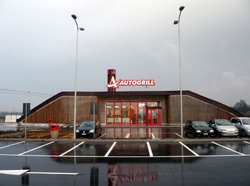The business case for tapping geothermal energy
The business case for tapping geothermal energy
Keeping costs to a minimum is a basic business tenet, irrespective of the economic climate. But higher energy prices have prompted some companies to look for innovative and environmentally friendly ways to save money. Italy’s Autogrill, based just outside Milan, has given itself the double task of not only cutting its spending on energy and water but also reducing its environmental impact. The company, the world’s biggest manager of airport and highway restaurants and shops, in 2008 spent €103 million on energy and water globally, 16% of its operating costs.
 |
| The “Ecogrill” near Ravenna |
The concept is simple and widely used in countries such as Sweden, Germany and Switzerland. Emerging markets include Italy, Spain, Turkey and south-eastern Europe. It bears little resemblance to geothermal electricity generation, which requires temperatures in the ground of at least 150°C. A heat pump works by sending a refrigerant liquid through tubes in the ground, where the warmth makes it expand into a gas. When the gas is forced back into liquid form, heat is released for use in hot water or heating. Heat pumps can usually be reversed to provide cooling, in which case they work exactly like a common refrigerator.
Autogrill has installed heat pumps at five of its 900 rest stops along Italy’s motorway network: three have vertical drillings directly in the soil and two use existing wells going down to the water table. Heat pumps have the advantage of saving Autogrill the cost of buying fuel oil and electricity for heating water, refrigeration and air conditioning. One of the ground-water units reduces electricity consumption for refrigeration by 40%, for example. The company can also benefit from a reliable, year-round source of energy that slashes carbon emissions (heat pumps need a small amount of external energy to function so they are not zero-carbon).
Acid test
But there is a snag. The cost of drilling the geothermal field and installing the tubes into the ground is more expensive in Italy than in many other European countries, says Gianluca Metti, head of technical services for Autogrill Italia. The heat pump itself is paid for after three or four years, thanks to the savings on fuel and electricity. But it can take up to 15 years to re-coup the cost of the whole installation, including the initial drilling, Metti adds.
‘In Italy, we still don’t have the kind of experience they have in northern Europe or in Switzerland,’ explains Metti. In theory, as many as 30% of Autogrill’s motorway service stations in Italy could be suitable for heat pumps, Metti estimates, but cost considerations will determine how many of these are actually taken forward.
The state doesn’t help much, unlike with other forms of renewable energy. Only Piedmont’s regional government provides funding, contributing €100,000 for Autogrill to install two heat pumps at Viverone, on the motorway running up to the Mont Blanc tunnel. Elsewhere, the company has to find efficiencies of its own. In the one case where the motorway service station was connected to the natural gas grid, Metti was able to install a so-called tri-generation unit, producing electricity along with heat and cooling. Near Ravenna, Autogrill in January opened an ‘ecological’ outlet rated Class A for energy efficiency with a grass roof and heat pump, cutting carbon-dioxide emissions and water consumption at that location by 30%. This year will see the acid test for Autogrill: whether to install a geothermal heat pump at a much larger, 2,600 square-metre service station that is planned at Villoresi, north of Milan.
Autogrill is clearly still experimenting with this technology, but it is joining other big names in Italy, such as Ikea. It is significant that companies are finding economical ways of adopting renewable energy. The Italian Geothermal Union estimates the capacity of heat pumps and other direct uses of geothermal energy could increase by five to seven times by 2020. Clearly, that will require lower costs or some form of state support.